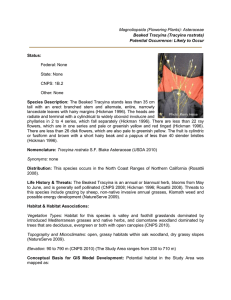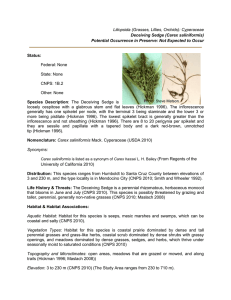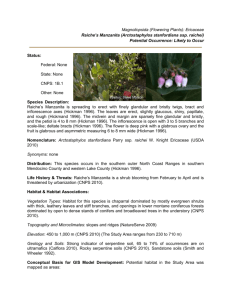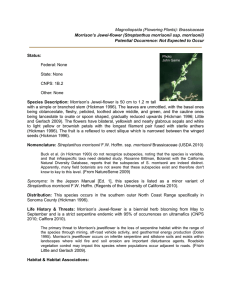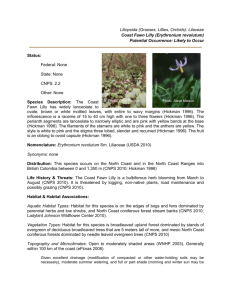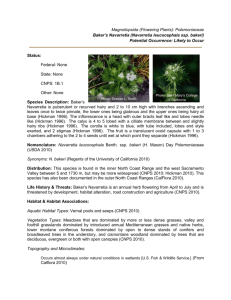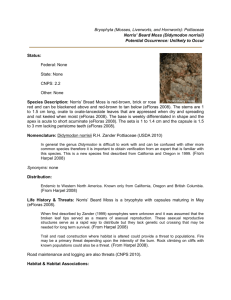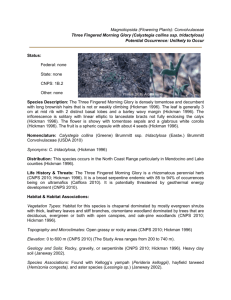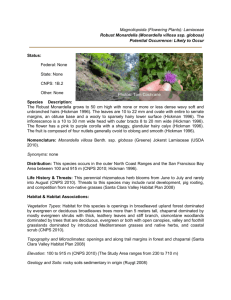POEP Text - Sonoma State University
advertisement
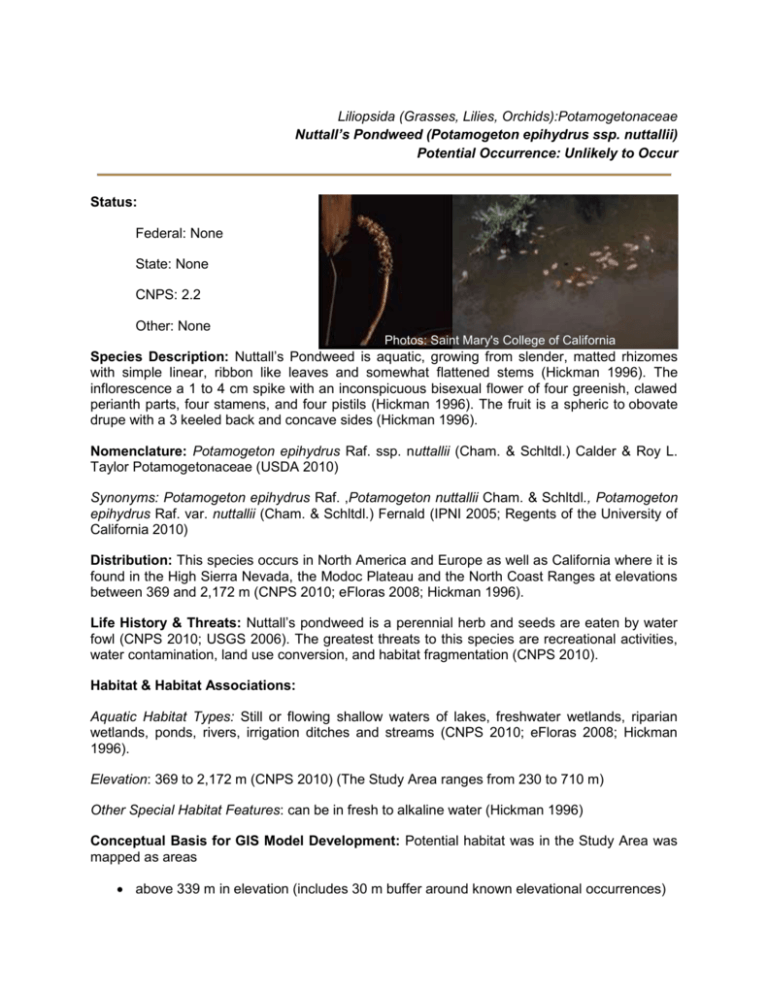
Liliopsida (Grasses, Lilies, Orchids):Potamogetonaceae Nuttall’s Pondweed (Potamogeton epihydrus ssp. nuttallii) Potential Occurrence: Unlikely to Occur Status: Federal: None State: None CNPS: 2.2 Other: None Photos: Saint Mary's College of California Species Description: Nuttall’s Pondweed is aquatic, growing from slender, matted rhizomes with simple linear, ribbon like leaves and somewhat flattened stems (Hickman 1996). The inflorescence a 1 to 4 cm spike with an inconspicuous bisexual flower of four greenish, clawed perianth parts, four stamens, and four pistils (Hickman 1996). The fruit is a spheric to obovate drupe with a 3 keeled back and concave sides (Hickman 1996). Nomenclature: Potamogeton epihydrus Raf. ssp. nuttallii (Cham. & Schltdl.) Calder & Roy L. Taylor Potamogetonaceae (USDA 2010) Synonyms: Potamogeton epihydrus Raf. ,Potamogeton nuttallii Cham. & Schltdl., Potamogeton epihydrus Raf. var. nuttallii (Cham. & Schltdl.) Fernald (IPNI 2005; Regents of the University of California 2010) Distribution: This species occurs in North America and Europe as well as California where it is found in the High Sierra Nevada, the Modoc Plateau and the North Coast Ranges at elevations between 369 and 2,172 m (CNPS 2010; eFloras 2008; Hickman 1996). Life History & Threats: Nuttall’s pondweed is a perennial herb and seeds are eaten by water fowl (CNPS 2010; USGS 2006). The greatest threats to this species are recreational activities, water contamination, land use conversion, and habitat fragmentation (CNPS 2010). Habitat & Habitat Associations: Aquatic Habitat Types: Still or flowing shallow waters of lakes, freshwater wetlands, riparian wetlands, ponds, rivers, irrigation ditches and streams (CNPS 2010; eFloras 2008; Hickman 1996). Elevation: 369 to 2,172 m (CNPS 2010) (The Study Area ranges from 230 to 710 m) Other Special Habitat Features: can be in fresh to alkaline water (Hickman 1996) Conceptual Basis for GIS Model Development: Potential habitat was in the Study Area was mapped as areas above 339 m in elevation (includes 30 m buffer around known elevational occurrences) drainages and ponds with perennial water Potential Occurrence in the Galbreath Wildlands Preserve: Habitat: Nuttall’s Pondweed occurs in perennial water above 369 m elevation. Within the Preserve, potential habitat is restricted to upper portions of 3 tributaries to Rancheria Creek, and two ponds (one is man-made). The quantity of potential habitat is overestimated (Figure 16); although all of these tributaries retain water in some areas throughout the summer, not all sections of the tributaries shown are perennial. Habitat quality in these areas is likely moderate because water quality has likely been impacted by increased erosion during the long history of logging on Preserve lands. Nearest Occurrence: Documented Occurrences in Galbreath Wildlands Preserve: Previous species list for the Galbreath Wildlands Preserve did not document this species (SSU Field Station and Nature Preserves 2010). Nearest Occurrence to Galbreath Wildlands Preserve: Nuttall’s Pondweed range is described as occurring in the North Coast Ranges, but has been documented only in Mendocino County. Of the 8 documented occurrences (Calflora 2010), the nearest is approximately 40 miles north of the Galbreath Wildlands Preserve in Willits in the Upper Main Eel River watershed (Calflora 2010). Occurrence of this species on the Preserve would be a southern range extension in coastal California (Calflora 2010). Summary: We anticipate Nuttall’s Pondweed to be “Unlikely to Occur” in the Preserve. While habitat quality may be moderate, a history of logging suggests that habitat quality was likely poorer in the past, and occurrence at the Preserve would constitute a 40 miles southward range extension for the species. References Calflora. 2010. Information on California plants for education, research and conservation. [web application]. <http://www.calflora.org/>. Accessed 2010 Jun 19. California Native Plant Society (CNPS). 2010. Inventory of Rare and Endangered Plants. Online edition, v7-10b. <http://www.cnps.org/inventory>. Accessed 2010 Jun 19. eFloras 2008. Flora of North America. Published on the Internet <http://www.efloras.org>. Accessed 2010 Jun 27. Hickman JC editor. 1996. The Jepson Manual Higher Plants of California. 3rded.. London: University of California Press, Ltd. 1304 p. International Plant Name Index (IPNI). 2005. <http://www.ipni.org/>. Accessed 2010 Jun 27. Regents of the University of California. 2010. The Jepson Online Interchange California Floristics. <http://ucjeps.berkeley.edu/interchange/> Accessed 2010 Jul 20. Saint Mary’s College of California. 1995. Potamogeton epihydrus ssp. nuttallii Nuttall’s Pondweed. < http://calphotos.berkeley.edu/cgi-bin/img_query?rel-taxon=contains&wheretaxon=Potamogeton+epihydrus+ssp.+nuttallii>, Accessed 2011 Arp 30. SSU Field Stations and Nature Preserves. 2010. Galbreath Wildlands Preserve Vascular Plant List. <http://www.sonoma.edu/preserves/docs/galbreath_vascular_plants.pdf>. Accessed 2010 Jun. United States Department of Agriculture (USDA). 2010. PLANTS Profile. <http://plants.usda.gov/java/profile?symbol=USLO50>. Accessed 2010 Jul 20. United States Geological Survey [USGS]. 2006. Northeast Wetland Flora Field Office Guide to Plant Species. <http://www.npwrc.usgs.gov/resource/plants/florane/species/4/potaepih.htm>. Accessed 2010 Jun 27. Species Account Description: Linden Schneider
